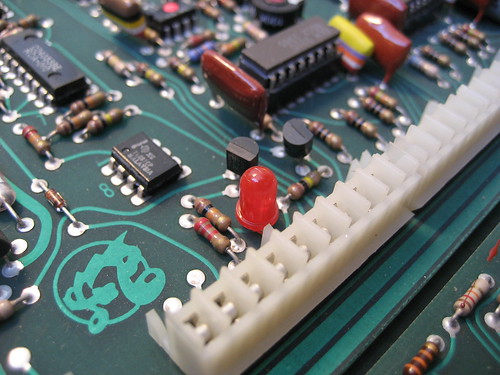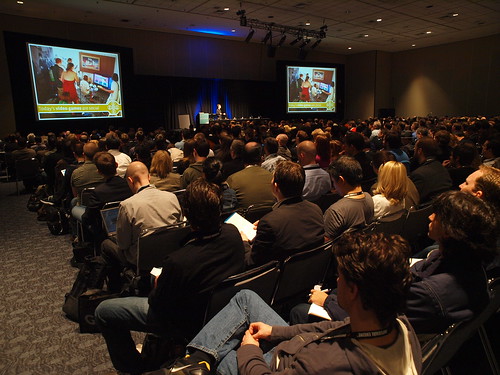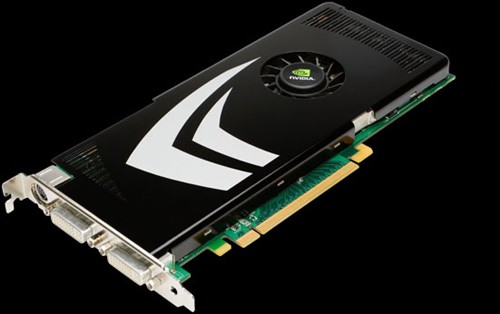PC Game also known as a computer game or personal computer game. It is a game played on a personal computer, rather than on a video game console or arcade machine. Computer games have evolved from the simple graphics and gameplay of early titles like Spacewar!, to a wide range of more visually advanced titles.

Photo: Pablo Bigatti
PC games are created by one or more game developers, often in conjunction with other specialists and either published independently or through a third party publisher. They may then be distributed on physical media such as DVDs and CDs, as Internet-downloadable, possibly freely redistributable, software, or through online delivery services such as Direct2Drive and Steam. PC games often require specialized hardware in the user's computer in order to play, such as a specific generation of graphics processing unit or an Internet connection for online play, although these system requirements vary from game to game.
PC Game History
As of the 2000s, PC games are often regarded as offering a deeper and more complex experience than console games. The first generation of PC games were often text adventures or interactive fiction, in which the player communicated with the computer by entering commands through a keyboard. An early text-adventure, Adventure, was developed for the PDP-11 by Will Crowther in 1976, and expanded by Don Woods in 1977. By the 1980s, personal computers had become powerful enough to run games like Adventure, but by this time, graphics were beginning to become an important factor in games. Later games combined textual commands with basic graphics, as seen in the SSI Gold Box games such as Pool of Radiance, or Bard's Tale.
By the mid-1970s, games were developed and distributed through hobbyist groups and gaming magazines, such as Creative Computing and later Computer Gaming World. These publications provided game code that could be typed into a computer and played, encouraging readers to submit their own software to competitions. Microchess was one of the first games for microcomputers which was sold to the public. First sold in 1977, Microchess eventually sold over 50,000 copies on cassette tape.

Photo: krunkwerke
PC Game New Era
Further improvements to game artwork were made possible with the introduction of the first sound cards, such as AdLib's Music Synthesizer Card, in 1987. These cards allowed IBM PC compatible computers to produce complex sounds using FM synthesis, where they had previously been limited to simple tones and beeps. However, the rise of the Creative Labs Sound Blaster card, which featured much higher sound quality due to the inclusion of a PCM channel and digital signal processor, led AdLib to file for bankruptcy in 1992.
The year before, id Software had produced one of the first first-person shooter games, Hovertank 3D, which was the company's first in their line of highly influential games in the genre. There were other companies that made fps shooters such as Day of the Viper from the company Accolade made in 1989. Id Software went on to develop Wolfenstein 3D in 1992, which helped to popularize the genre, kick-starting a genre that would become one of the highest-selling in modern times. The game was originally distributed through the shareware distribution model, allowing players to try a limited part of the game for free but requiring payment to play the rest, and represented one of the first uses of texture mapping graphics in a popular game, along with Ultima Underworld.
While leading Sega and Nintendo console systems kept their CPU speed at 3-7 MHz, the 486 PC processor ran much faster, allowing it to perform many more calculations per second. The 1993 release of Doom on the PC was a breakthrough in 3D graphics, and was soon ported to various game consoles in a general shift toward greater realism. In the same time frame, games such as Myst took advantage of the new CD-ROM delivery format to include many more assets (sound, images, video) for a richer game experience.
Many early PC games included extras such as the peril-sensitive sunglasses that shipped with The Hitchhiker's Guide to the Galaxy. These extras gradually became less common, but many games were still sold in the traditional over-sized boxes that used to hold the extra "feelies". Today, such extras are usually found only in Special Edition versions of games, such as Battlechests from Blizzard.

Photo: Official GDC
PC Game Development
Game development, as with console games, is generally undertaken by one or more game developers using either standardized or proprietary tools. While games could previously be developed by very small groups of people, as in the early example of Wolfenstein 3D, many popular computer games today require large development teams and budgets running into the millions of dollars.
PC games are usually built around a central piece of software, known as a game engine, that simplifies the development process and enables developers to easily port their projects between platforms. Unlike most consoles, which generally only run major engines such as Unreal Engine 3 and RenderWare due to restrictions on homebrew software, personal computers may run games developed using a larger range of software. As such, a number of alternatives to expensive engines have become available, including open source solutions such as Crystal Space, OGRE and DarkPlaces.
The real-time strategy genre, which accounts for more than a quarter of all PC games sold, has found very little success on video game consoles, with releases such as Starcraft 64 failing in the marketplace. Real-time strategy games tend to suffer from the design of console controllers, which do not allow fast, accurate movement.

Photo: chrisinplymouth
PC Game Accessories
Modern computer games place great demand on the computer's hardware, often requiring a fast central processing unit (CPU) to function properly. CPU manufacturers historically relied mainly on increasing clock rates to improve the performance of their processors, but had begun to move steadily towards multi-core CPUs by 2005. These processors allow the computer to simultaneously process multiple tasks, called threads, allowing the use of more complex graphics, artificial intelligence and in-game physics.
Similarly, 3D games often rely on a powerful graphics processing unit (GPU), which accelerates the process of drawing complex scenes in realtime. GPUs may be an integrated part of the computer's motherboard, the most common solution in laptops, or come packaged with a discrete graphics card with a supply of dedicated Video RAM, connected to the motherboard through either an AGP or PCI-Express port. It is also possible to use multiple GPUs in a single computer, using technologies such as NVidia's Scalable Link Interface and ATI's CrossFire.
Sound cards are also available to provide improved audio in computer games. These cards provide improved 3D audio and provide audio enhancement that is generally not available with integrated alternatives, at the cost of marginally lower overall performance. The Creative Labs SoundBlaster line was for many years the de facto standard for sound cards, although its popularity dwindled as PC audio became a commodity on modern motherboards.

Photo: Jenson_2008
Physics processing units (PPUs), such as the Nvidia PhysX (formerly AGEIA PhysX) card, are also available to accelerate physics simulations in modern computer games. PPUs allow the computer to process more complex interactions among objects than is achievable using only the CPU, potentially allowing players a much greater degree of control over the world in games designed to use the card.
Virtually all personal computers use a keyboard and mouse for user input. Other common gaming peripherals are a headset for faster communication in online games, joysticks for flight simulators, steering wheels for driving games and gamepads for console-style games.
Source: wikipedia.org
Read more [ ... ]









